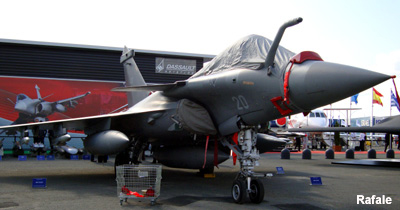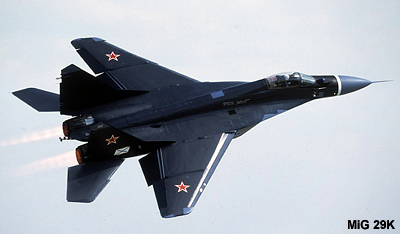|
Ministry of Defence and industry sources indicate
that the RFI, issued recently, is of a “generic’
nature, looking for newer platforms and airborne
technologies and what is on offer from some of
the well-known manufacturers. That is, there is
no planned induction at the moment.
Among others, the RFI has been issued to the
US Boeing for Super Hornet F/A 18, to BAE Systems
for Eurofighter Typhoon, French Dassault for Rafale,
Rosoboronexport for newer Russian Mig or Sukhoi
shipboard fighters
The number of newer generaion aircraft is yet
to be decided, but these will be in addition to
the 45 Mig 29Ks the Navy is buying from Russia,
16 of which were ordered in 2004 along with Admiral
Gorshkov.
The order for an additional 29 Mig 29Ks is being
processed and is likely to placed shortly after
price negotiations and delivery schedule are worked
out.
 There
should be no delay from Russia on the supply of
the Mig 29K, a modernized naval variant of the
Mig 29 operational with the Indian Air Force (IAF)
although it has delayed the delivery of Gorshkov
by four years and is also demanding an extra $
1.2 billion over and above the contract price
of $ 974 million. The old carrier was given free
and this price was for repairing and refurbishing
the carrier, damaged in an onboard fire accident. There
should be no delay from Russia on the supply of
the Mig 29K, a modernized naval variant of the
Mig 29 operational with the Indian Air Force (IAF)
although it has delayed the delivery of Gorshkov
by four years and is also demanding an extra $
1.2 billion over and above the contract price
of $ 974 million. The old carrier was given free
and this price was for repairing and refurbishing
the carrier, damaged in an onboard fire accident.
The Super Hornet, a successor of the earlier
Hornet, was introduced in 1998 for the US Navy
while Rafale, a successor of the old Mirage 2005,
has both air force and naval versions already
operational. Both these aircraft are also competing
for the nearly 200 Medium Multi Role Combat Aircraft
(M-MRCA) requirement of the Indian Air Force.
BAE Systems’s spokesman Guy Douglas said
that the company had “provided information
to, and are continuing in discussions with, the
Indian Navy regarding navalised Eurofighter Typhoon.”
Eurofighter Vice President and Head of India
Campaign Directorate Dr Matthias Schmidlin told
India Strategic that his company would bid for
the Indian Navy’s requirement whenever invited.
He observed that Eurofighter is the only aircraft
among the six contenders for the IAF order which
will have true thrust vectoring capability in
the coming years to facilitate shipboard operations.
 Some
200 Eurofighters have been produced so far, predominantly
to meet the requirements of participating nations
in the Eurofighter programme which include Germany,
Britain, Spain and Italy. Some
200 Eurofighters have been produced so far, predominantly
to meet the requirements of participating nations
in the Eurofighter programme which include Germany,
Britain, Spain and Italy.
Thrust vectoring is being developed and would
be operational on Eurofighters within the first
half of the next decade, Dr Schmidlin said.
Harrier, which India bought in the late 1970s
from Britain, was the first aircraft with thrust
vectoring, which allows an aircraft to takeoff
and land even in vertical mode like a helicopter.
The Joint Strike Fighter (JSF) being developed
by Lockheed Martin for US Air Force and Navy for
the coming years, will have this capability.
Besides Boeing, Dassault and Eurofighter, the
other contenders in the IAF competition are Mig
35 (a newer version of Mig 29), Gripen from Sweden
and F 16 Viper IN (US Lockheed Martin).
The Indian naval brass is reportedly only doing
a bit of loud thinking on its new requirement,
but if it formally opens the competition in the
coming years, it would add a new dimension to
the IAF’s ongoing contest.
IAF’s Request for Proposals (or tenders),
is for a firm order for 126 aircraft and for 63
more as an option at the same price. Given the
continuing fall in the number of IAF squadrons
due to the obsolescence of its largely Soviet-vintage
aircraft, a repeat order for at least 100 more
MRCAs is likely.
If the Indian Navy chooses the same aircraft,
then it would be a bonus for the supplier, and
also for HAL, which would be the lead integrator
for Transfer of Technology (ToT) and 50 per cent
offset mandatory in the IAF RfP.
Procedurally, the Navy would also find it easier
to buy the same aircraft without opening an international
competition, as it would be a follow-on order
requiring no multi-vendor bid.
 The
Indian Navy has one small aircraft carrier, INS
Viraat, which has recently been refitted and modernized
for life-extension. There are a dozen old Harriers
to operate from its deck, while Gorshkov will
be available in 2012 or 2013. The
Indian Navy has one small aircraft carrier, INS
Viraat, which has recently been refitted and modernized
for life-extension. There are a dozen old Harriers
to operate from its deck, while Gorshkov will
be available in 2012 or 2013.
Notably, Gorshkov is a 44000-tonne carrier while
India’s first indigenous aircraft carrier
will only have about 37,000-tonne displacement.
The second carrier, already sanctioned by the
government, could be modified to be a little bigger.
Both these carriers are being designed by Italy’s
Fincantieri.
According to Chief of Naval Staff Admiral Nirmal
Verma, the newer aircraft were actually being
considered for operations from India’s second
aircraft carrier. The Navy is gathering information
to design and build a sophisticated carrier with
futuristic aircraft.
It may also be noted that both Eurofighter and
Rafale are smaller in size than the F 18 Super
Hornet, which operates from very large US aircraft
carriers floating in all the oceans.
But Boeing IDS’ Head for India, Dr Vivek
Lall, told India Strategic that
Boeing had done a computer simulation to verify
that the Super Hornet could operate from Gorshkov
and Indian carriers as and when they are commissiond.
|